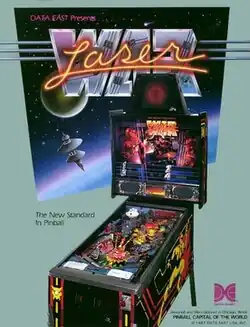Laser War
 Laser War flyer | |
| Manufacturer | Data East Pinball |
|---|---|
| Release date | May 1987 |
| System | DataEast/Sega Version 1 |
| Design | Joe Kaminkow |
| Programming | Rehman Merchant |
| Artwork | Kevin O'Connor, Margaret Hudson |
| Music | David Thiel |
| Sound | David Thiel |
| Production run | 2,569 |
Laser War is the first pinball machine that was produced by Data East Pinball. It was the first pinball machine to feature digital stereo sound,[1] and is loosely based on Lazer Tag.[2]
Data East had been trying to get a pinball division for 2 years before this machine to sell them through their existing distribution network.[3] The game was first revealed in November 1986, and completed and tested before its release in May 1987.[4]
Design
This is notable as the "first pinball specifically designed for digital stereo", which included a subwoofer. There are separate ROMs for voice and music, and includes advanced speech. The digital speakers are in a chrome enclosure as part of the backbox,[5] and are slightly angled to face the player.[6] While he assisted with some previous machines, this is the first machine that David Thiel completed all of the sound and music for.[7]
The backglass shows a laser war in progress.[2]
Topper
The machine was designed with a topper, but only the first 500 or so machines were issued with one.[8] This is based on the Lyte sound visualizer manufactured by Clyde Industries which displays kaleidoscopic patterns from audio input.[9] This is housed in a trapezoidal case, and uses the unamplified sound from the sound board for its input.
Layout
There is a kickback in the left outlane. There are three groups of three stand-up targets: red on the left side, blue on the right side, and yellow towards the middle. There is a corresponding lock/kickout for each colour, with the red and yellow including a spinner that the ball hits before reaching them. The table has a single ramp, with a wireform return to the right flipper; where this ramp turns a laser-gun turret is located which lights up at various points during a game. The top left of the machine has W-A-R rollovers just above three pop-bumpers.[10]
Gameplay
The table is controlled with two flippers, and has a manual plunger. By hitting all three targets in a colour group the player lights a lock, and after locking two balls, the two ball multiball starts. This can be turned into a three ball multiball by locking these balls again, which enables a jackpot to be collected by hitting the ramp.[11][6]
Reception
In a review for Play Meter, Roger Sharpe gave the game 3.5/4 with a layout that is fair to an average player, yet still challenging for a more skilled player.[12]
References
- ^ Michael Shalhoub (2012). The Pinball Compendium. Schiffer. p. 88. ISBN 978-0-7643-4107-6.
- ^ a b Harris, Steve (January 1988). "Player's Picks The Best of the AMOA, Part II". Play Meter. Vol. 14, no. 1. pp. 166–167.
- ^ Cognevich, Valerie (April 1987). "Coinman interview". Play Meter. Vol. 13, no. 4. pp. 24–36.
- ^ Shird, Jim (September–October 1987). "Data East enters the pinball sweepstakes". Top Score. pp. 1, 6.
- ^ "Laser War". Play Meter. Vol. 13, no. 6. June 1987. p. 72.
- ^ a b TNT Amusements Inc (2013-04-11). #183 Data East's first Pinball Machine LASER WAR - first Stereo Sound game! TNT Amusements. Retrieved 2025-08-12 – via YouTube.
- ^ "PINBALL EXPO 2014". Pinball News. October 2014. Retrieved 2025-07-04.
- ^ Kaminkow, Joe; Manley, Les (2014). "1987 Data East Laser War Topper? | post #11". pinside.com. Retrieved 2025-08-10.
- ^ "New products". Modern Electronics. December 1987. p. 14.
- ^ Harris, Steve (November 1987). "Player's Picks". Play Meter. Vol. 13, no. 11. pp. 128–129.
- ^ "Laser War instruction card" (PDF). 1987.
- ^ Sharpe, Roger C. (February 1988). "Critic's corner". Play Meter. Vol. 14, no. 2. p. 77.cite mag